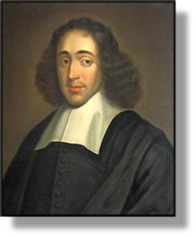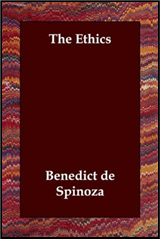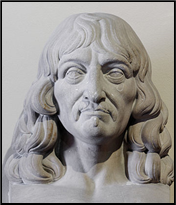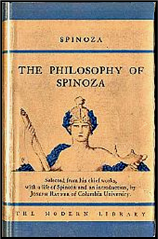


xxxxxFrom an early age, the Dutch philosopher Baruch Spinoza questioned the nature of God and the immortality of the soul. His works included a Treatise on God, Man and his Well-
BARUCH SPINOZA 1632 -
Acknowledgements
Spinoza: 1665, artist unknown – Herzog August Bibliothek, Wolfenbuttel, Germany. Descartes: late 18th century bust, artist unknown – Sainte-
 xxxxxThe Dutch philosopher Baruch Spinoza was born in Amsterdam of Portuguese parents. They were well respected members of the Jewish community there, and it is likely that Spinoza attended the city's school for Jewish boys. An able, inquisitive young man, he soon began to question the orthodox doctrines of his faith and those of Christianity. He argued that there were inconsistencies in the Bible, and that this seriously challenged the idea that its contents had been totally inspired by God. He then went on to question the nature of God and the immortality of the soul. The local Jewish leaders, failing to keep him silent on such matters -
xxxxxThe Dutch philosopher Baruch Spinoza was born in Amsterdam of Portuguese parents. They were well respected members of the Jewish community there, and it is likely that Spinoza attended the city's school for Jewish boys. An able, inquisitive young man, he soon began to question the orthodox doctrines of his faith and those of Christianity. He argued that there were inconsistencies in the Bible, and that this seriously challenged the idea that its contents had been totally inspired by God. He then went on to question the nature of God and the immortality of the soul. The local Jewish leaders, failing to keep him silent on such matters -

xxxxxFor the next five years he lived just outside Amsterdam, supporting himself by working as a grinder of optical lenses for spectacles, microscopes and telescopes. He than lived for two or three years at Rijnsburg, and it was during this period that he completed two of his works: a Treatise on God, Man and His Well-
xxxxxWhile at Rijnsburg he also worked on his Treatise on Religious and Political Philosophy. It was published anonymously in 1670, and came in for some severe criticism from the Christian Church. In its political theory, however, he advocated religious tolerance and intellectual freedom. He argued that no government possessed a divine authority, and should be resisted if it no longer protected the rights of its people or turned against them. In the same year he moved to The Hague. Here he was offered a chair in philosophy at Heidelberg University, and a pension from Louis XIV, but, determined to maintain his intellectual freedom, he declined both.
 xxxxxHis philosophy was much influenced by the theories of the French philosopher René Descartes (illustrated), but he could not accept, above all, his dualism of mind and body. Adopting a rational approach in order to discover the truth about reality -
xxxxxHis philosophy was much influenced by the theories of the French philosopher René Descartes (illustrated), but he could not accept, above all, his dualism of mind and body. Adopting a rational approach in order to discover the truth about reality -
 xxxxxSuch ideas, broadly based on Cartesian philosophy but belonging to no recognised school, were somewhat difficult to accept or, indeed, understand in parts. The German philosopher Gottfried Wilhelm Leibniz, who met Spinoza in 1676, and who was himself a rationalist, questioned some aspects of his reasoning, including the arbitrary definition of "substance". It is not surprising, therefore, that his system did not give rise to any particular school of thought, and that his highly individual approach failed to gain recognition until a century after his death. The idea of an impersonal God, for example, was not well received, and his general hypothesis was described by the French encyclopedist Pierre Bayle as "most monstrous", and by the Scottish philosopher David Hume as "hideous”. Nevertheless, his concepts have left their mark on philosophical thinking down the ages -
xxxxxSuch ideas, broadly based on Cartesian philosophy but belonging to no recognised school, were somewhat difficult to accept or, indeed, understand in parts. The German philosopher Gottfried Wilhelm Leibniz, who met Spinoza in 1676, and who was himself a rationalist, questioned some aspects of his reasoning, including the arbitrary definition of "substance". It is not surprising, therefore, that his system did not give rise to any particular school of thought, and that his highly individual approach failed to gain recognition until a century after his death. The idea of an impersonal God, for example, was not well received, and his general hypothesis was described by the French encyclopedist Pierre Bayle as "most monstrous", and by the Scottish philosopher David Hume as "hideous”. Nevertheless, his concepts have left their mark on philosophical thinking down the ages -
xxxxxSpinoza died of tuberculosis at The Hague in 1677, the cause of his death being clearly linked to the inhaling of glass dust during his many years as a lens grinder.
C2-


